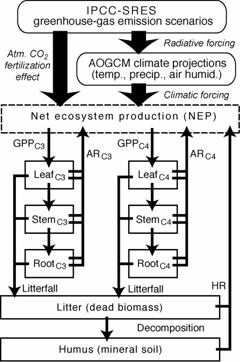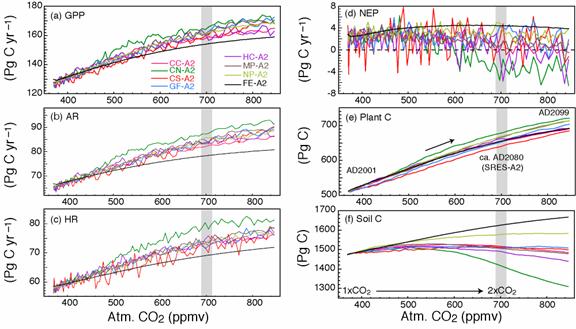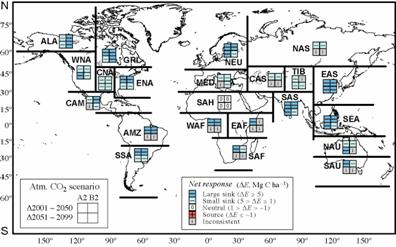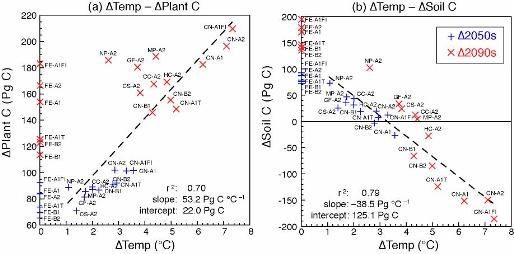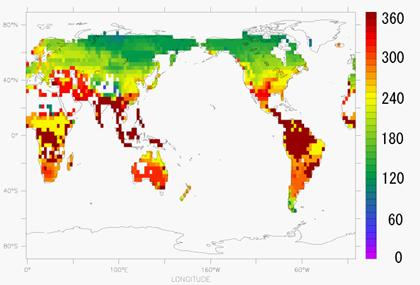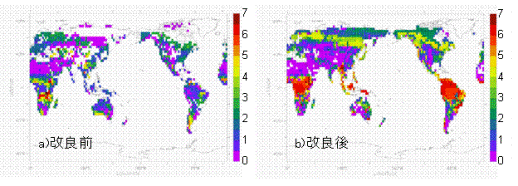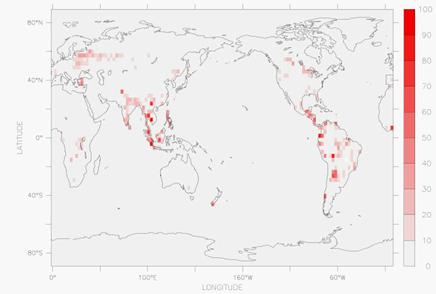1. Carbon cycle model, carbon cycle and climatic change joint model | |||||||||||||||||||||||||||||||||||||||||||||||||||||||||||||||||||||||||||||||||||||||||||||||||||||||||||||||||||||||||||||||||||||||||||||||||||||||||||||||||||||||||||||||||||||||||||||||||||||||||||||||||||||||||||||||||||||||||||||||||||||||||||||||||||||||||||||||||||||||||||||||||||||||||||||||||||||||||||||||||
1-1. Terrestrial carbon cycle modelThe organization in charge: Earth environment frontier research center
a. SummaryIt is the target of this subgroup to include in the earth system integrated model which builds the model which simulates the carbon cycle by a terrestrial ecosystem, and is built with this subject when building the earth environment change forecasting model by artificial greenhouse gas discharge, and to perform warming prediction. FY 2004 -- (1) Sim-CYCLE off-line evaluation, combination of (2) Sim-CYCLE and MATSIRO-AGCM, and (3) -- it worked following the last fiscal year about three points of inclusion of the carbon balance process by artificial land use change. b. Research purposethe carbon balance of the present earth -- being artificial (fossil fuel expenditure-land use diversification etc.) -- an abbreviation half remains in the atmosphere among the discharged carbon dioxide (they will be about 7 PgC/year at the 1980s), and the remaining half is absorbed by ocean and terrestrial. The terrestrial ecosystem has played the role important for the carbon balance of the earth also from a global aspect. However, in the present carbon cycle research, the carbon balance of a terrestrial ecosystem has many unsolved problems, and is further considered to be one of the factors which enlarge uncertainty of prediction also in the future earth environment change prediction by greenhouse gas discharge. If some researches using an earth system integrated model are compared, future carbon dioxide levels and climate change prediction change greatly with between models (for example, Friedlingstein et al.2003), and the difference in the response of the carbon balance to earth environment change of a terrestrial ecosystem is considered to be one big factor. The purpose of this subgroup is including in the earth system integrated model which builds the model which is highly precise and presumes (1) terrestrial ecosystem carbon cycle, and is built in (2) this subjects. Although breathing by the photosynthesis and the plant by a plant, and edaphone is main as carbon balance between the atmosphere and terrestrial vegetation, in order to reproduce a long-term ecosystem, it is necessary to take into consideration the complicated various process in the inside of an ecosystem. It is rare to be solved about those physiological ecology character, and although derivation of a general model leaves an experiential portion from a difficult thing, it needs to aim at parameterization with few errors. Therefore, modeling is advanced, promoting the observation project and cooperation of symbiosis 3rd (terrestrial ecosystem) etc. If in charge of inclusion to an earth system integrated model, the more reliable simulation in consideration of the interaction of climate and a carbon cycle becomes possible by combining a terrestrial carbon cycle model to the present air-sea joint general circulation model (AOGCM). For example, if it may work in the direction which vegetation absorbs more CO2 by extending the vegetation growing season in a cold district by warming, and eases CO2 concentration rise, a soil organic matter decomposition rate accelerates by warming, and CO2 concentration rise may be promoted. The simulation in consideration of the link of such climates and carbon cycles becomes possible. c. A research program, a method, and a schedule- FY 2002 - 2004 : simple substance evaluation of a terrestrial modelWhen building an earth system integrated model, each component fully needs to be verified. About verification of a model, he is the ground observation group of the (1) symbiosis 3rd (terrestrial), the young woman using the continuation observational data of the water, the heat, and carbon dioxide exchange between air-terrestrial by the flux group of the Ministry of Environment general research promotion expense S1 etc. -- comparison of the satellite observational data (LAI, absorptance of photosynthetically active radiation, photosynthesis quantity of production of vegetation) of broad-based vegetation activity and a model point estimate by the satellite observation group of verification of a product base and the (2) symbiosis 3rd (terrestrial) etc. is performed. Off-line evaluation of a model is performed in parallel to verification of the above-mentioned model. The carbon balance in the past - the present global scale is reproduced, and change of the terrestrial carbon cycle under future carbon dioxide levels and climate change scenario conditions is simulated. The elucidation by an off-line simulation is advanced about the factor of the uncertainty of the future prediction in the present integrated model research using the climate scenario reproduced under various greenhouse gas discharge scenario conditions. - FY 2002 - 2004ar : combination to construction and the general circulation model of a terrestrial integrated modelIt is most efficiently attained by this group in construction of a terrestrial integrated model by combining the both model of the Sim-CYCLE model (Ito and Oikawa, 2002) reproducing a carbon cycle, and the MATSIRO model (Takata et al., 2003) reproducing heat and a water cycle. About the interaction of air-terrestrial, MATSIRO calculates heat and water exchange, and a photosynthetic rate based on LAI by Sim-CYCLE. Based on the amount of photosynthesis by the MATSIRO, Sim-CYLE calculates many process inside ecosystems, such as distribution to each part of vegetation, consumption by breathing or withering to death, and decomposition in soil. That is, it has a complementary relation of obtaining the net amount of exchange as the sum total because MATSIRO presumes the CO2 absorption to terrestrial from the atmosphere and Sim-CYCLE presumes the CO2 discharge from terrestrial. - FY 2003 - 2005 : model extension for both integrated model comparison project participationInternationally, some trials to an integrated model exist besides this project. In order to perform more synthetic evaluation from the background, the international comparison project (Coupled Climate Carbon Cycle Model Intercomparison Project:C4MIP; both climate-carbon cycle joint model comparison project) of an earth system integrated model was shown in FY 2003. Now, the model simulation for comparison of each endowed institution is performed. This subject is also considered to be an indispensable condition when performing competition with international participating in this project, and a measure is advanced. The interaction of a terrestrial carbon cycle model and a general circulation model is to give CO2 concentration in the 20th century, and land use change data as an input of a model, and to be evaluated as the first step, and the procedure document (protocol) of an experiment is also shown. This correspondence is performed. - FY 2004 - 2006As a next stage, extension for taking structural change of a terrestrial ecosystem into consideration is performed. The more nearly actually near prediction experiment in consideration of composition change of the vegetable types (an evergreen broad-leaved tree, a shrub, grassy place, etc.) which constitute an ecosystem from linking with the dynamic vegetation distributed model which the terrestrial dynamic state subgroup of this subject develops is conducted. It is made to converge on the integrative model about MATSIRO, Sim-CYCLE, and terrestrial that linked the vegetation dynamic model. The prediction experiment by the integrated model which finally introduced the influence which a water heat budget-carbon balance-vegetation change in structuretextural change has on a climate system is conducted. d. The research program in FY 2004this fiscal year -- (1) Sim-CYCLE off-line evaluation, combination of (2) Sim-CYCLE and MATSIRO-AGCM, and (3) -- three points of examination 、 of inclusion of the carbon balance process by artificial land use change are performed. It is as follows for details. (1) Sim-CYCLE off-line evaluationIt is pointed out that change of the carbon balance in a terrestrial ecosystem affects it to advance of a climate change strongly from the warming prediction research using two or more climate models. Although a terrestrial carbon cycle scheme (Sim-CYCLE) is included in the earth system integrated model developed with symbiosis 2 subject, the climate-carbon cycle preceded performing the on-line joint experiment which performs an interaction, and the off-line experiment which investigates the response sensitivity to the climate change given as external force has been conducted. (2) Combination of Sim-CYCLE and MATSIRO-AGCMIn order to build a climate-terrestrial carbon cycle joint model, combination of CCSR/NIES/FRCGC AGCM5.7b (included MATSIRO) and Sim-CYCLE was performed. Although combination to MATSIRO through the coupler contained in Formula Translator-izing and GCM of a Sim-CYCLE code by the last fiscal year of Sim-CYCLE was advanced, since many imperfect portions were in the code, bug picking etc. was improved. Moreover, since the calculation step was changed into day by day from existing every month also about the Sim-CYCLE simple substance portion, off-line spin nappe during 1000 years by improvement of a phenology expression portion, re-tuning of a parameter, and Sim-CYCLE after improvement was performed. (3) Inclusion of the carbon balance process by artificial land use changeAbout the model which unified a carbon cycle and climate, C4MIP (The Coupled Climate-Carbon Cycle Model Intercomparison Project; both carbon cycle-climate joint model comparison project) is trying to start. On the first stage of this project, in order to have focused on the terrestrial carbon cycle and to participate in it, it is necessary to presume CO2 burst size accompanying an artificial land use change (conversion to cultivated land from natural vegetation). In the current fiscal year, introduction of CO2 discharge protocol for it (Grand Slam Protocol) was performed to the climate-terrestrial carbon cycle joint model completed by (2). e. Reports in FY 2004A research program is followed and it is (1). Sim-CYCLE off-line evaluation and (2) The inclusion to AGCM of a terrestrial model, and (3) Three points of examination 、 of the model extension for both integrated model comparison project participation were performed. Details are shown below. e.1. Sim-CYCLE off-line evaluatione.1.1. The outline of a terrestrial carbon cycle scheme (Sim-CYCLE) Sim-CYCLE (Simulation model of Carbon cYCle in Land Ecosystems; Ito and Oikawa 2002) was used for the CO2 exchange between air-terrestrial, and the simulation of the carbon dynamic state inside an ecosystem. As this model is shown in Fig. 1, it consists of a C3 plant (a leaf, the trunk and branch, and root), a C4 plant (a leaf, the trunk and branch, and a root; distributed only over a prairie ecosystem), and soil (a withering-to-death thing and mineral soil layer), and all of a main carbon flaw and its environmental response are calculated explicitly. The gross primary production (GPP) by photosynthesis is influenced as an environmental factor of solar insolation, air CO2, temperature, and soil moisture, and receives control by the stomata conductance (function of photosynthesis, air CO2, and saturation deficit) of phylloplane, and the form (a leaf area index and extinction coefficient) of a canopy as a biotic factor. Calculating autotrophy-breathing (AR) of vegetation by 2 element model of maintenance respiration and composition breathing, maintenance respiration treats the function of the biomass and temperature, and composition breathing as a function of the increase speed in the biomass. Heterotrophism-breathing (HR) by a soil microorganism serves as soil temperature and a function of soil moisture. The difference of this GPP and AR+HR expresses the net income and outgo (namely, influence on the atmosphere CO 2) of the whole ecosystem, and is called pure ecosystem production (NEP). To air CO2 concentration, only GPP has sensitivity, and the response curve is expressed with a saturated type curve (the response the C3 plant is higher than a C4 plant is shown). temperature -- receiving -- both GPP AR and HR -- although -- although it has sensitivity, since AR differs in GPP from a single Mine type function, and differs from an exponential function and the response curve differs in HR from an Arrhenius function, it is difficult to judge the response of NEP to temperature variation intuitively.
In order that selection of a scenario might influence a result greatly in an off-line experiment, in this research, the plan which makes the most of the scenario group in which data distribution is performed from IPCC Data Distribution Center while it was used in the analysis of an IPCC Third Assessment Report was taken. It becomes possible to evaluate the range of fluctuation seen by doing so between setup (IPCC-SRES scenario) of a different air-sea joint general circulation model (AOGCM) or artificial origin discharge. Here, as mentioned to Table 1, six kinds of SRES scenarios (A1B, A1T, A1FI, A2 and B1, B-2) and the climate change prediction scenario in the 21st century by seven kinds of AOGCM(s) (CCCma, CCSR/NIES, CSIRO, GFDL, HadCM3, ECHAM) were used. The difference between SRES scenarios mainly originates in the difference in a human society-factor the setting conditions of future population growth, economic growth, fossil fuel expenditure, and innovation etc. On the other hand, the difference between AOGCM(s) originates in the difference among physical factors, such as parameterization, such as spatial resolution, and a cloud, land, sea ice. However, the experiment corresponding to six kinds of SRES scenarios is not conducted by all AOGCM(s). The output value of the monthly average temperature, precipitation, and atmospheric humidity in 2001- 2099 was used from each AOGCM output. Since they differed in the unit (specific humidity, dew point temperature, relative humidity) of not only spatial resolution but atmospheric humidity, they were sampled by 0.5 spatial resolution, and the unit of atmospheric humidity was unified into specific humidity. Although the ensemble experiment of three members is conducted and the ecosystem model experiment was conducted about each member in HadCM3 and CCCma, only the 1st member's result was used for comparison here (although the difference in the result between different members reflected the uncertainty by a nonlinear factor, great difference was not produced as far as terrestrial carbon balance is concerned). Table 1: Combination of Off-line experiment, and conclusion of ecosystem carbon balance in the 21st century (-).
e.1.3. A simulation and analysis All ball calculation was performed in 0.5 spatial resolution and time resolution one month. Vegetation distribution did not take into consideration the vegetation change during the 21st century, and land use conversion using the existing vegetation map (32 kinds) by Olson. The spin up to an experiment start (2001) was performed in two steps. Air CO2 concentration as of 1900 (about 296 ppmv) and the long-term average climate in the 20th century were used for the 1st, and it calculated repeatedly until carbon balance would be in the steady state in each lattice point. Climate data and air CO2 concentration (based on ice sheet core data and an air concentration continuous observation) by UEA/CRU of a survey base was inputted into the 2nd by the time series about the period in 1901- 2000, and it was made to experience the environmental variation during the 20th century. During the experimental period in 2001- 2099, the climate change scenario by the air CO2 concentration change and AOGCM based on an IPCC-SRES scenario was used for the drive variable. However, the value which added the change ingredient to the average of the 1990s to the average value of UEA/CRU was carried out instead of raw data with input data from the problem of the reproducibility about the roughness of the spatial resolution of AOGCM, and the present climatic conditions. Furthermore, in order to separate the direct influence of an air CO2 concentration rise (the photosynthesis fertilizing effect and stomata closing), and the influence of a climate change, climatic conditions conducted the experiment to which it fixed to at the present and only air CO2 concentration was changed. e.1.4. Result GPP(s), AR(s), and HR by the terrestrial ecosystem at the time of an experiment start (the 2000s) were 127.9, 65.8, and 58.2 Pg C yr-1, respectively. global net primary productivity (NPP) 62.1 Pg C yr-1 can be said to be appropriate as compared with 60 Pg C yr-1 shown in the IPCC Third Assessment Report. Although the carbon storage of vegetation and a soil organic matter was set to 515 and 1479 Pg C, respectively, these were also within the limits of the conventional presumed result. The result in which examination is performed by Ito (2000), Ito and Oikawa (2000, 2004), etc. and the present presumed result by Sim-CYCLE is in general appropriate about many aspects of affairs, such as a difference during a vegetation type, latitude distribution, and a seasonal variation, is obtained. - The response to an air CO2 concentration riseIn the experiment which raised only air CO2 concentration, GPP showed the remarkable increase for the photosynthesis fertilizing effect. The extent was proportional to the increment of the atmosphere CO 2 by a SRES scenario mostly, and the A1FI scenario (source serious consideration type society of fossil energy) with the CO2 most remarkable increase showed the increase in +30.6 Pg C yr-1 (+23.6%) by the 2090s. On the other hand, the CO2 increase had stopped at B1 scenario (self-sustaining development type society) controlled comparatively at the abbreviation half of A1FI, and the increase in +15.7 Pg C yr-1 (+12.1%). Although the air CO2 concentration rise did not have direct influence on breathing of vegetation, withering to death, and microbe breathing, the increase in photosynthesis production caused the increase in the biomass (+114-183 Pg C), and caused the increase in a withering-to-death thing, and the increase in a soil organic matter (+136-195 Pg C) indirectly. Uncertainty exists in CO2 dishoarding prediction of (2) human-activities origin which may have reaction for the carbon cycle of a terrestrial ecosystem with an independently material (1) air CO2 concentration upsurge, and the main point of this experimental result has become one of the causality which gives the band to terrestrial carbon balance prediction with big it. - The response to an air CO2 concentration rise + climate changeIn the experiment which gave the climate change in addition to the air CO2 concentration rise, terrestrial carbon balance showed the complicated action (Fig. 2). Since facilitatory effects, such as extension of the growth period accompanying warming and mitigation of the moisture stress by the increase in precipitation, exceeded the depressor effect by high temperature stress, drying, etc. to GPP, compared with the experiment of only the CO2 fertilizing effect, GPP increased greatly (+29.5-48.1 Pg C yr-1). AR was made to increase by 17.0-28.5 Pg C yr-1, and, as for the increase in the biomass and rise in temperature by the increase in GPP, HR also showed the increase in 15.5-23.0 Pg C yr-1. As a result, the vegetable biomass (mainly the trunk and root of a forest ecosystem) was functioning as a carbon sink of 146-210 Pg C during the 21st century. On the other hand, even if the difference of the soil organic matter was large between scenarios and having been limited to SRES-A2, even when becoming the sink of 103PgC(NCAR) and becoming the sauce of 149PgC(CCSR/NIES) from from, the response separated (when having become sauce uses CCSR/NIES and the scenario of HadCM3). As the whole ecosystem, it was shown during the 21st century that it may function as a net source of CO2 absorption in any case (+24.3-288.7 Pg C). However, when limited in the second half of the 21st century, while the CO2 fertilizing effect approached saturation, in some scenarios, the terrestrial ecosystem may have become net CO2 discharge field for the rise in temperature which advances at an increasing tempo.
Although generating unevenly spatially was shown, it became clear that the climate change during the 21st century of the climate forecast experiment by AOGCM is time and to have the heterogeneity to which the response of terrestrial carbon balance also corresponded. Although Fig. 3 shows the terrestrial carbon balance response for every geographic division based on Giorgi & Francisco (2000), it turns out that it is a uncertain factor that a qualitative change of not only the quantitive difference of CO2 income and expenditure but a sink/sauce exists for every area. For example, drying strong in HadCM3 was predicted and the control tendency of GPP was remarkable in Amazon lowlands compared with other cases. Moreover, although the rise in temperature in Northern Hemisphere high latitude was more remarkable than other areas at any AOGCM, especially in CCSR/NIES, the tendency was strong, therefore the net CO2 discharge from a soil ecosystem was predicted in the second half of the 21st century.
e.1.5. Conclusion It is Fig. 4 which plotted the response of GPP to the temperature variation from the 2000s to the 2090s of the 2050s, the vegetable biomass, and a soil organic matter about each experiment. Although the grades of a rise in temperature differ by the scale of CO2 increase, or the response sensitivity of AOGCM, it turns out through the whole that GPP and the vegetable biomass increase greatly, so that rise-in-temperature width is large. Thereby, the vegetable biomass shows a negative-feed-back-action to CO2 increase and a rise in temperature. On the other hand, the tendency which an absorbed amount not only decreases, but becomes a net discharge field in connection with a rise in temperature above near present ratio +3.7 ℃ was shown by the soil organic matter. This can be considered to be a positive feedback-action by the soil organic matter under strong warming conditions. Even when a common terrestrial ecosystem model was used by this off-line experiment, a possibility that the response of carbon balance changed greatly with differences of the prediction scenario of air CO2 concentration or climatic conditions was shown. This can be said to the research and 供 of Cramer et al. (2001) which showed the difference in a response of six kinds of terrestrial ecosystem models to a common scenario as the trial which clarified uncertainty of feedback effect presumption to the climate change by terrestrial. although the on-line experiment using the climate-carbon cycle joint model considered to be close to the action of a present more actual earth system is tried -- a scenario/model same also there -- it has suggested that it is necessary to fully examine specific uncertainty.
(2) Combination of Sim-CYCLE and MATSIRO-AGCM Although combination to MATSIRO through the coupler contained in Formula Translator-izing and GCM of a Sim-CYCLE code by the last fiscal year of Sim-CYCLE was advanced, since there were many imperfect portions, such as a program mistake, about delivery of the climate value from MATSIRO to Sim-CYCLE, and delivery of CO2 flux from Sim-CYCLE to GCM-MATSIRO, and LAI (leaf area index), improvement of bug picking or a code was performed first. Next, in response to the fact that the calculation step was changed into day by day from existing every month about the Sim-CYCLE simple substance portion, off-line spin nappe during 1000 years by improvement of a (1) phenology expression portion, re-tuning of (2) parameter, and Sim-CYCLE after (3) improvement was performed. About the phenology expression portion, in order to do work easy in the future at the time of the combination to the integrated model of SEIB-DGVM (Sato et al.), it decided to use a setup adopted by the DGVM. The model system of Botta et al. (2000) is adopted as calculation of an opening day within this model. Each Plant Functional Type (PFT) is classified into five phenology types, and the model controlled by each variable, such as an addition growth degree day (Growing Degrees Day: GDD), increase days of GDD, increase days of soil moisture, and a net primary production (NPP) of ten daily means, respectively is applied. By this improvement, calculation spaced at one day was attained about the foliation opening day of an every place point, and distribution of a growing season became realistic (Fig. 5). Then, as a result of giving re-tuning to a vegetable parameter, also about each productive capacity (GPP, NPP) of an ecosystem, all ball distribution of carbon accumulation (a plant body and soil carbon, LAI), or all ball total amounts, compared with a former thing, it can be improved sharply, and a realistic value can be outputted now (Fig. 6). From the above thing, it is thought that the climate-terrestrial carbon cycle joint model was completed mostly.
(3) Inclusion of the carbon balance process by artificial land use change Although the interaction of a climate-carbon cycle gives big feedback to a climatic change, the uncertainty of the size is high. Some endowed institutions in the inside of the world are moving to development of the integrated model of a climate-carbon cycle, and both the climate-carbon cycle joint model comparison project (Coupled climate-carbon cycle model intercomparison project:C4MIP) was shown in such a situation. This project aims at grasping the range of the sensitivity of a climate-carbon cycle system, and the characteristic of each model by using the experimental condition of common input data etc. for various independent models. Finally, the atmosphere in a climate-carbon cycle system and a set of simulations of the climatic change which combined the component, which are terrestrial and the ocean, will be performed over the 20th century and the 21st century. Although the mutual comparison by a climate-terrestrial carbon cycle joint model is planned as the first step (Phase 1) of C4MIP, according to the protocol, it is mentioning introducing the carbon discharge process by land use change as a necessary condition for participating. Since it corresponded to this protocol, in our model, the carbon dynamic state change process by land use change was introduced according to Grand Slam Protocol (Houghton et al., 1983). In this process, it is the mechanism of calculating diversification of the crop land rate in each grid for every year, and changing a carbon backlog and the amount of dynamic states in another process every three diversification patterns, using the data set which stored diversification of the crop land rate of each year first. (1) Changeover of natural vegetation to a crop land. (2) Cultivation. (3) Abandonment of a crop land. For example, all the vegetation biomasses of the grid which changed to the crop land are removed, and are distributed to the pool which returns to the atmosphere with the time scale for one year, ten years, and 100 years. Moreover, a part is stored as soil carbon. In cultivated land, when it produces using the existing model (for example, cultivated land model of Sim-CYCLE) and cultivated land is abandoned, natural vegetation will carry out regrowth.
This fiscal year completed coding for tackling the carbon dynamic state change process by land use change. Now, the trial run by a C4MIP-oriented joint model is performed. According to it, about 100 years in 1900 to 1999, in western Europe, Southeast Asia, and Central America, discharge of the carbon by the conversion to cultivated land from natural vegetation was seen (Fig. 7), and discharge of 58PgC(s) was checked in 100 years with all balls. Although it is necessary to examine the validity of this result from now on, it is thought that introduction of a protocol was successful at present. f. Consideration The work planned in FY 2004 went smoothly. Although the project has been advanced in the current fiscal year with emphasis on the environmental management and details adjustment of a joint model, the following fiscal year is due to be performed focusing on the experiment using the completed joint model. Specifically, it is planning investigating about the relation between the carbon dynamic state in the 20th century using a Sim-CYCLE-MATSIRO-AGCM joint model, and land use change, and prediction of the climate-carbon dynamic state interaction change during the 21st century. Moreover, aiming at improvement in the further accuracy, things advanced further, such as comparison verification with verification of the model using field observational data, such as the 3rd subject of symbiosis and the Ministry of Environment synthesis promotion expense S1, taking in of the new knowledge of various ecosystem processes, satellite data, etc., are planned also about the Sim-CYCLE simple substance model. g. Bibliography Botta A. et al. (2000) A global prognostic scheme of leaf onset using satellite data. Global Change Biology, 6, 709-725. h. The announcement of a result<Society announcement>Akihiko Ito . Change of an ecosystem on land, and earth-environment . earth frontier symposium: Thing - at an atmospheric change and the point of the global warming - Kyoto Protocol, Tokyo, and August 4, 2004 Kato, T., Tang, Y., Gu, S, Cui, X., Hirota, M., Du, M., Li, Y., Zhao, X., Oikawa, T.CO2 exchanges between the atmosphere and an alpine meadow ecosystem on the Qinghai-Tibetan Plateau.American Geophysical Union (AGU) Fall Meeting, San Francisco, December 17, 2004. CO2 income and outgo in a Tomomichi Kato . plateau prairie ecosystem - present condition and future prediction-. general invitation symposium -- "-- : which explores the carbon dynamic state in Omi and the Tibet prairie ecosystem -- the present condition, the 52nd time convention of the view". Ecological Society of Japan, Osaka-shi, and March 28, 2005. <Paper announcement> Kato, T., Hirota, M., Tang,Y., Cui, X., Li, Y., Zhao, X., Oikawa, T. (in press) Strong temperature dependence and no moss photosynthesis in winter CO2 flux for a Kobresia meadow on the Qinghai-Tibetan Plateau. Short communication, Soil Biology and Biochemistry. Gu, S., Tang, Y., Cui, X., Kato, T., Du, M., Li, Y., Zhao, X. (2005) Energy exchange between the atmosphere and a meadow ecosystem on the Qinghai-Tibetan Plateau. Agric. For. Meteorol. 129(3-4), 175-185. Ito A. (2005) Climate-related uncertainties in projections of the 21st century terrestrial carbon budget: off-line model experiments using IPCC greenhouse gas scenarios and AOGCM climate projections. Climate Dynamics, 24:435-448. Ito A. (2005) Regional variability in the terrestrial carbon-cycle response to global warming in the 21st century: simulation analysis with AOGCM-based climate projections. Journal of the Meteorological Society of Japan, 83:251-259. Fang, J., Oikawa, T., Kato, T., Mo, W., Wang, Z. (2005) Biomass carbon accumulation by Japan's forests from 1947 to 1995. Global Biogeochem. Cycles, 19, GB2004, doi:10.1029/2004GB002253. Akihiko Ito, Kazuhito Ichii, Katsunori Tanaka, the Hisashi Sato、 Seita Emori, Takehisa Oikawa (2004) The terrestrial model used by an earth system model: Present condition and subject . of research The weather 51 : 227-239 Next Page (1.2 Oceanic carbon cycle model) | |||||||||||||||||||||||||||||||||||||||||||||||||||||||||||||||||||||||||||||||||||||||||||||||||||||||||||||||||||||||||||||||||||||||||||||||||||||||||||||||||||||||||||||||||||||||||||||||||||||||||||||||||||||||||||||||||||||||||||||||||||||||||||||||||||||||||||||||||||||||||||||||||||||||||||||||||||||||||||||||||
